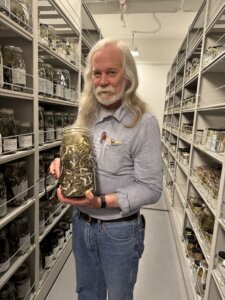This video is no longer available.
Students at Powell Elementary School in D.C. studied the red-backed salamander and thought that its red strips looked like the District’s flag.
Now the D.C. Council is considering a bill to designate the red-backed salamander — aka the Plethodon cinereus — as the official “state amphibian of the District of Columbia.”
If the bill becomes law, the official state amphibian would take its place alongside other official D.C. symbols, such as the Wood thrush, the Scarlett oak, and the cherry.
The bill will be heard in a Committee of the Whole meeting in September, with a possible vote in the fall.
The red-backed salamander is most commonly found in the city’s woodlands, including Rock Creek Park. They’re the most abundant vertebrate in eastern Americans forests — even more than deer.
“They’re a small animal, typically four inches long, long tail, four legs, moist skin,” said Addison Wynn, museum technician on the collections management staff at the Smithsonian’s Museum Support Center in Suitland.
Wynn’s area of expertise is salamanders, particularly eastern North American salamanders such as the red-backed.
The Museum Support Center is the research and collections hub of the Smithsonian Institution. The facility is home to more than 31 million objects.
“The red-backed salamander is the most common salamander in the area … in the Eastern United States. There are, in the right habitat, up to 1,000 or more per acre,” Wynn said.

The slimy creatures are a bit elusive and not so easy to see, although there are plenty of them. That’s because they don’t hang out in the sunlight, unlike lizards.
“Typically, they live underground. They’re very secretive, come up to the surface only at night. And even then, under specialized conditions. They come up on the surface at night less when there’s a full moon, for example, because the moonlight would allow predators to see them more. … They just live secretive lives underground, coming to the surface rarely,” Wynn said.
The passing of the bill would also bring forth “Amphibian Week” from May 5-11, which would encourage D.C. residents to get outside and “turn over a fallen log and search for a red-backed salamander.”
Get breaking news and daily headlines delivered to your email inbox by signing up here.
© 2024 WTOP. All Rights Reserved. This website is not intended for users located within the European Economic Area.








